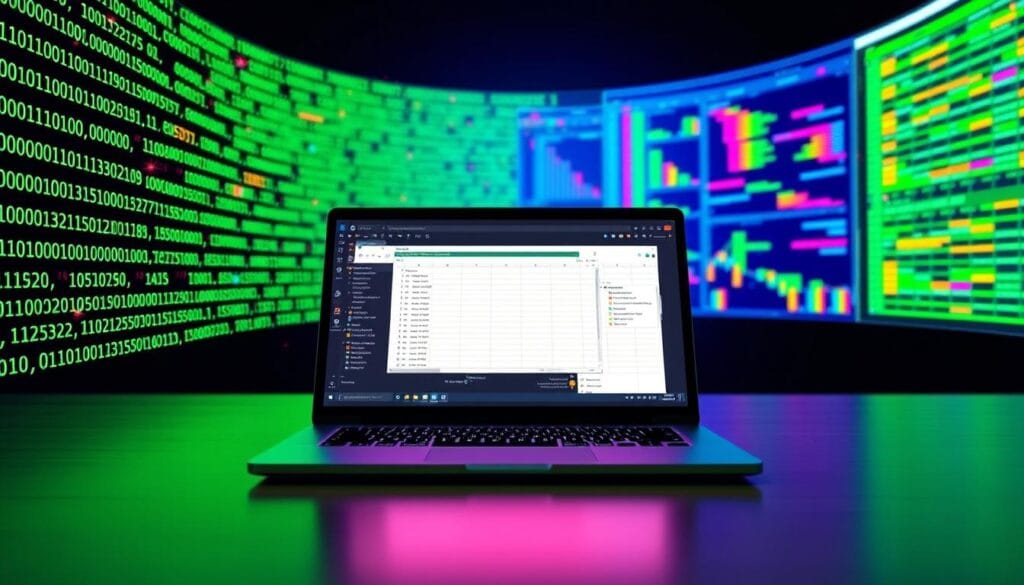Table of Contents
Do you need to convert Microsoft Excel binary worksheet to excel? I got you. Imagine working late on a critical report. The clock is ticking, and your Excel file is full of valuable data. You’ve spent weeks organizing it. Then, you find out it’s a binary file (.xlsb) and you need to share it with a colleague in the regular Excel format (.xlsx).

Panic sets in as you worry about the conversion process. But, there’s no need to stress. You can easily convert that Microsoft Excel binary worksheet to Excel without any trouble.
Whether you’re dealing with complex data, extensive macros, or everyday spreadsheets, converting Excel binary files is a breeze. It’s a game-changer for your productivity.
Key Takeaways
- Understanding the ease of converting Microsoft Excel binary worksheet to Excel.
- Recognizing the benefits of converting binary files to .xlsx format.
- Simple steps ensure even those with minimal technical knowledge can follow along.
- Enhanced accessibility and ease of use with converted files.
- Relief from potential data-sharing obstacles and better collaboration with colleagues.
Understanding Excel Binary Files
To fully grasp how to execute an excel binary format conversion, it’s crucial to understand the nature of Excel Binary Files (XLSB). They have distinct advantages over standard Excel formats. These files enhance performance and efficiency.
What is an Excel Binary File?
An Excel Binary File, commonly referred to by its .xlsb extension, is a type of Excel workbook saved in binary format. This is different from the more widespread .xlsx format. Binary files are compact and optimized for speed. They are particularly useful for large datasets and complex spreadsheets.
Benefits of Using Excel Binary Files
There are several notable advantages when opting to convert binary workbook to excel:
- Smaller File Sizes: XLSB files tend to be smaller compared to XML-based files. This saves disk space and enhances processing times.
- Faster Performance: Due to their storage format, operations such as opening, saving, and calculating are quicker. This significantly improves efficiency.
- Better Handling of Complex Data: XLSB files are more adept at managing large datasets and complicated formulas. They are a go-to choice for intensive data tasks.
Common Scenarios of Using Excel Binary Files
Understanding when to use Excel Binary Files can significantly influence your data processing strategies. Here are some typical scenarios:
- Large Datasets: If you’re working with extensive data, converting your files to binary format can improve the speed and efficiency of data manipulations.
- Complex Spreadsheets: When dealing with workbooks that include numerous formulas, macros, and links, binary files offer a seamless performance boost.
- Limited Storage: When storage space is at a premium, the smaller file size of XLSB can be highly beneficial.
By leveraging the advantages offered by Excel Binary Files, you can enhance your data operations. Through thoughtful application, you can utilize the benefits of excel binary format conversion to optimize your workflow.
Preparing for Conversion
Before you start converting binary excel files to regular excel, it’s important to prepare. These steps help make the conversion smooth and keep your data safe.
Backing Up Your Binary Files
First, make sure you have a backup of your binary files. This step is key to avoid losing important data during the conversion. Use safe backup methods like external hard drives or cloud storage.
System Requirements
Next, check if your computer can handle the conversion. You need:
- Operating System: Windows 7 or later, macOS 10.12 or later
- Microsoft Excel: Version 2010 or newer
- Minimum 4GB RAM
- Stable internet for online tools
Software and Tools Needed
Lastly, gather the right software and tools for the job. You’ll need a compatible Microsoft Excel version and possibly third-party tools. Some top choices are:
- Microsoft Excel’s built-in save-as function
- Third-party converters like Zamzar and CloudConvert
- Automated scripts for bulk conversions
With good preparation, converting your binary excel files will be quick and safe. This saves you time and keeps your data intact.
Step-by-Step Guide to Convert Microsoft Excel Binary Worksheet to Excel
Turning a Microsoft Excel Binary Worksheet into a regular Excel file is easier than you think. We’ll show you how to open, save, and check the file. This guide will help you do it all by yourself.
Opening the Binary Excel File
To start, you need to know how to open the binary Excel file. Just follow these steps:
- Open Microsoft Excel on your computer.
- Click on the “File” menu and select “Open”.
- Navigate to the location of your binary Excel file (*.xlsb) and select it.
- Click “Open” to load the file in Excel.
Saving as a Regular Excel File
Once the binary file is open, it’s time to save it as a regular Excel file. Here’s how:
- Click on the “File” menu again and choose “Save As”.
- Select the location where you want to save the converted file.
- In the “Save as type” dropdown menu, select “Excel Workbook (*.xlsx)”.
- Click “Save”.
Now, your binary worksheet is saved in the regular Excel format. You can edit it like any other Excel file.
Verifying the Conversion
The last step is to check if the conversion worked right. Follow these steps:
- Open the newly saved .xlsx file in Excel.
- Make sure all data, formulas, and formatting are the same as the original binary file.
- Check important things like pivot tables, charts, and macros to see if they work.
- If you find any problems, use a binary worksheet converter tool to help fix them.
This step is key to making sure the conversion was done right.
Using an Excel Binary to Excel Converter Tool
Using a converter tool makes it easier to switch binary Excel files to standard formats. This part covers the basics, from what these tools do to their pros and cons.
Introduction to Converter Tools
An excel binary to excel converter helps turn binary Excel files (.xlsb) into formats like .xlsx. These tools make the complex process simple. They keep data safe, ensure it looks right, and make it easy to use.
Popular Converter Tools Available
Many binary worksheet converter tools are out there, each meeting different needs. Some top picks include:
- Microsoft Excel – Offers built-in conversion options.
- Zamzar – Popular for its easy-to-use online conversion service.
- Online-Convert – Known for its comprehensive format support.
- CoolUtils – Versatile tool with batch conversion capabilities.
Pros and Cons of Using Converter Tools
Converter tools make switching formats easier, but it’s good to know the good and bad sides:
| Pros | Cons |
|---|---|
| Faster conversion with minimal manual effort | May require internet access for online tools |
| Preserves data integrity and formatting | Some tools may have file size limitations |
| Supports bulk and batch conversions | Potential cost for premium versions |
Manual Conversion Process
If you like doing things yourself or don’t have access to converter tools, this section is for you. We’ll show you how to manually convert a binary workbook.
Manually Save Binary to Regular Excel
Converting an Excel binary worksheet to a regular Excel file is easy. Just follow these steps:
- Open the binary Excel file you want to convert.
- Go to the File menu and choose Save As.
- Pick where you want to save the new file.
- In the Save as type dropdown, select Excel Workbook (*.xlsx).
- Click Save to finish the conversion.
This way, you can convert Microsoft Excel binary worksheet to Excel format by yourself. Your data stays safe.
Handling Complex Workbooks Manually
Working with complex workbooks can be tricky. They might have hard formulas, macros, or big datasets. Here are some tips to help:
- Check for Compatibility: Make sure all features in the binary file work in regular Excel. Some might need changes.
- Validate Macros: Check your macros after converting. Some might need to be re-coded.
- Split Large Workbooks: If your workbook is huge, break it into smaller files. This helps with memory.
- Test Calculations: After converting, check all complex calculations. This ensures no errors were made.
| Step | Description |
|---|---|
| Compatibility Check | Make sure all features work in the new format. |
| Validate Macros | Re-code any macro functionalities as needed. |
| Split Large Workbooks | Manage big data by splitting into smaller files. |
| Test Calculations | Check all complex calculations for accuracy post-conversion. |
By following these steps, you can confidently convert your Microsoft Excel binary worksheet to Excel format. Your data and functions will be safe.
Troubleshooting Common Issues
Running into tech problems when trying to convert binary workbooks to Excel is common. This part will help with issues like compatibility problems, error messages, and lost data.

File Compatibility Problems
Compatibility issues are a big problem. Some Excel versions can’t handle certain features in older or newer workbooks. Always check your Excel version is current. Also, back up your files before you start to avoid losing data.
Error Messages and Solutions
Error messages can slow you down and confuse you. You might see “File Not Recognized” or “Unsupported File Format”. First, check if the workbook is damaged. Then, make sure all software and plugins are installed right. Often, small fixes can solve big problems.
Recovering Lost Data
Lost data during conversion is a big worry. It’s key to have a plan for getting data back. Use Excel’s recovery tools or professional tools for Excel. Regular backups are also a good idea to avoid losing data.
How to Open Binary Excel File in Excel
Opening a binary Excel file in Microsoft Excel is easy. It lets you access your data quickly without any delays. First, open Microsoft Excel on your computer. Get to know the Open dialog box, which is key to the process.
- Click on the File tab in the top-left corner.
- Choose Open from the menu. This opens the Open dialog box, where you can find your files.
- In the dialog box, change the file type to include all files. This makes sure binary files are shown.
- Find and pick the binary Excel file you want to open.
- Click Open. Microsoft Excel will then show the binary file, letting you work with your data.
Knowing how to open binary Excel files in Excel helps you work with them better. It’s important for managing data well and keeping workflows smooth. After opening the file, you can analyze or convert it as needed.
To work better, learn about different file types. Sometimes, you might need to convert an Excel binary format for use on other platforms or systems. Using Excel’s built-in conversion tools can make this easier, keeping your data safe during changes.
Decoding Binary Excel Files for Advanced Users
For those who want to get the most out of their data, learning to decode binary Excel files is key. This part goes deep into the technical side. It offers advanced ways to get data back from binary Excel files.
Understanding the Technical Details
Excel binary files, with the .xlsb extension, are different from .xlsx files. They are better for performance and smaller in size. To decode these files, you need to know a few important parts:
- File Header: This section has metadata about the file.
- Workbook Data: It holds the workbook’s sheet structure and data.
- Cell Data: This part stores info about individual cells.
- Formatting: It includes cell styles, colors, and fonts used in the workbook.
Knowing these parts is the first step to converting Excel binary formats.

Advanced Techniques for Data Recovery
Getting data back from a damaged Excel binary file needs careful steps and special tools. Here are some advanced methods to help you get important data back:
- Hexadecimal Editors: Use tools like HxD or Hex Editor Neo to look at and change the file’s hexadecimal code. This can spot and fix small problems.
- Excel Specific Recovery Tools: Programs like Stellar Repair for Excel and Kernel for Excel offer special solutions for fixing damaged files.
- File Repair Services: If you can’t fix it yourself, try professional file repair services. They can handle tough cases of data loss and recovery.
Learning about these tools and methods can improve your skills in decoding and recovering data from binary Excel files.
Conclusion
In this guide, we covered how to convert Microsoft Excel binary worksheets to Excel. We looked at the basics of Excel binary files and the different ways to convert them. You now know how to make this process easy.
Converting these files has many benefits. It makes handling data easier and improves compatibility with other software. Tools like an Excel binary to Excel converter can help a lot. But, manual methods give you more control and understanding of your data.
Now, you know how to keep your data working well on different platforms. Whether you use a converter tool or do it manually, the aim is to make the process smooth. With the right tools and knowledge, converting Excel binary worksheets to Excel is simple and effective.
FAQ
What is an Excel Binary File?
An Excel Binary File (XLSB) is a special type of Excel spreadsheet. It’s made to store data more efficiently than the standard XLSX format. This makes it great for big datasets and complex spreadsheets, offering faster performance and smaller file sizes.
How can I convert a Microsoft Excel Binary Worksheet to an Excel file?
To change a Microsoft Excel Binary Worksheet (XLSB) to an Excel file (XLSX), you can use Excel or third-party tools. In Excel, just open the binary file and save it as a regular Excel file using the “Save As” function.
What are the benefits of using Excel Binary Files?
Excel Binary Files have many benefits. They are smaller, work faster, use less memory, and are more efficient with large datasets or complex calculations. This format is especially good when you need fast performance and to save space.
Do I need special software to convert Binary Excel files to regular Excel?
You can convert Binary Excel files to regular Excel using Excel’s built-in features. But, you can also use specialized converter tools for easier conversion. These tools might offer extra features and make the process simpler, especially for converting many files at once.
How should I prepare my files for conversion?
Before converting your Binary Excel files, back up your data to avoid losing anything. Make sure your system meets the requirements for any conversion tools you plan to use. Also, get familiar with the steps involved in the conversion process.
What are some recommended Excel Binary to Excel converter tools?
Good converter tools include Convertio, Zamzar, and onlineconvertfree.com. These tools have easy-to-use interfaces and can quickly and efficiently convert Excel Binary files to regular Excel.
What should I do if I encounter file compatibility problems during conversion?
If you run into compatibility issues, first check that you’re using the right file formats. Update your software if needed. If problems still happen, try another conversion method or tool.
How can I decode a Binary Excel file?
Decoding a Binary Excel file means understanding its technical details. You might need specialized software or programming skills to access and understand the binary data. This is best for technical users who know a lot about Excel file formats.
How can I manually convert a Binary Excel file to a regular Excel file?
To manually convert an XLSB file to XLSX, open it in Excel. Then, go to “File” > “Save As” and pick the Excel Workbook (*.xlsx) format. Make sure to check the converted file to ensure all data and formatting are correct.
Why should I verify my data after conversion?
Checking your data after conversion is key to keeping it accurate and complete. This step is vital to maintain data integrity and ensure your file works as expected.
What can I do if there is an error message during conversion?
If you get an error message, look at the specific error code or message. Check the user manual or support resources for your software or tool. Common fixes include checking file compatibility, ensuring enough system resources, and trying the conversion again with the right settings.
Is it possible to recover lost data from a Binary Excel file?
Yes, you can recover lost data from a Binary Excel file. You can use data recovery software or Excel’s built-in recovery options. Advanced users might also try manual recovery techniques by looking at the file’s binary structure.
You can read more how-to guides by clicking here.
Or you can check out our apps on the Play Store:

